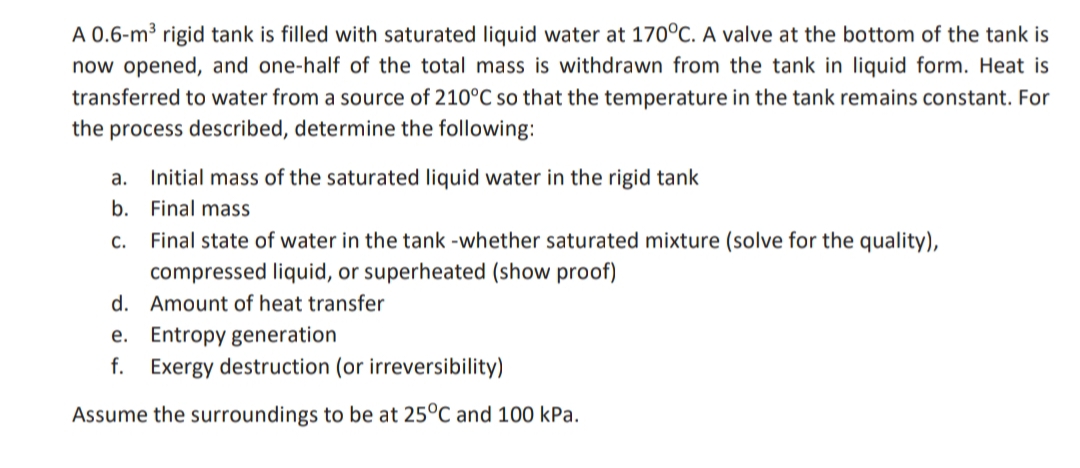A 0.6-m³ rigid tank is filled with saturated liquid water at 170°C. A valve at the bottom of the tank is now opened, and one-half of the total mass is withdrawn from the tank in liquid form. Heat is transferred to water from a source of 210°C so that the temperature in the tank remains constant. For the process described, determine the following: a. Initial mass of the saturated liquid water in the rigid tank b. Final mass C. Final state of water in the tank -whether saturated mixture (solve for the quality), compressed liquid, or superheated (show proof) d. Amount of heat transfer
A 0.6-m³ rigid tank is filled with saturated liquid water at 170°C. A valve at the bottom of the tank is now opened, and one-half of the total mass is withdrawn from the tank in liquid form. Heat is transferred to water from a source of 210°C so that the temperature in the tank remains constant. For the process described, determine the following: a. Initial mass of the saturated liquid water in the rigid tank b. Final mass C. Final state of water in the tank -whether saturated mixture (solve for the quality), compressed liquid, or superheated (show proof) d. Amount of heat transfer
Elements Of Electromagnetics
7th Edition
ISBN:9780190698614
Author:Sadiku, Matthew N. O.
Publisher:Sadiku, Matthew N. O.
ChapterMA: Math Assessment
Section: Chapter Questions
Problem 1.1MA
Related questions
Question
100%
ANSEER C AND D ONLY. SHOW COMPLETE AND LEGIBLE SOLUTION.

Transcribed Image Text:A 0.6-m³ rigid tank is filled with saturated liquid water at 170°C. A valve at the bottom of the tank is
now opened, and one-half of the total mass is withdrawn from the tank in liquid form. Heat is
transferred to water from a source of 210°C so that the temperature in the tank remains constant. For
the process described, determine the following:
a.
b.
C.
Initial mass of the saturated liquid water in the rigid tank
Final mass
Final state of water in the tank -whether saturated mixture (solve for the quality),
compressed liquid, or superheated (show proof)
Amount of heat transfer
d.
e. Entropy generation
f. Exergy destruction (or irreversibility)
Assume the surroundings to be at 25°C and 100 kPa.
Expert Solution
This question has been solved!
Explore an expertly crafted, step-by-step solution for a thorough understanding of key concepts.
Step by step
Solved in 3 steps with 3 images

Knowledge Booster
Learn more about
Need a deep-dive on the concept behind this application? Look no further. Learn more about this topic, mechanical-engineering and related others by exploring similar questions and additional content below.Recommended textbooks for you

Elements Of Electromagnetics
Mechanical Engineering
ISBN:
9780190698614
Author:
Sadiku, Matthew N. O.
Publisher:
Oxford University Press

Mechanics of Materials (10th Edition)
Mechanical Engineering
ISBN:
9780134319650
Author:
Russell C. Hibbeler
Publisher:
PEARSON

Thermodynamics: An Engineering Approach
Mechanical Engineering
ISBN:
9781259822674
Author:
Yunus A. Cengel Dr., Michael A. Boles
Publisher:
McGraw-Hill Education

Elements Of Electromagnetics
Mechanical Engineering
ISBN:
9780190698614
Author:
Sadiku, Matthew N. O.
Publisher:
Oxford University Press

Mechanics of Materials (10th Edition)
Mechanical Engineering
ISBN:
9780134319650
Author:
Russell C. Hibbeler
Publisher:
PEARSON

Thermodynamics: An Engineering Approach
Mechanical Engineering
ISBN:
9781259822674
Author:
Yunus A. Cengel Dr., Michael A. Boles
Publisher:
McGraw-Hill Education

Control Systems Engineering
Mechanical Engineering
ISBN:
9781118170519
Author:
Norman S. Nise
Publisher:
WILEY

Mechanics of Materials (MindTap Course List)
Mechanical Engineering
ISBN:
9781337093347
Author:
Barry J. Goodno, James M. Gere
Publisher:
Cengage Learning

Engineering Mechanics: Statics
Mechanical Engineering
ISBN:
9781118807330
Author:
James L. Meriam, L. G. Kraige, J. N. Bolton
Publisher:
WILEY